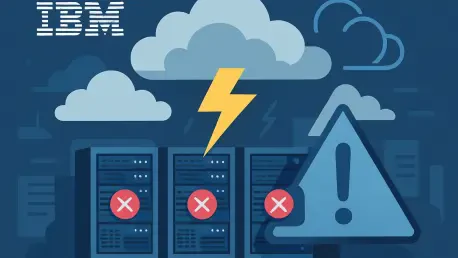What happens when a cornerstone of modern business—a trusted cloud provider—falters not once, but repeatedly, leaving global enterprises stranded without access to critical systems? IBM Cloud, a giant in hybrid cloud solutions, has stumbled through a series of major outages this year, disrupting vital operations for countless organizations. This isn’t just a technical hiccup; it’s a seismic event shaking the foundation of trust in cloud infrastructure. The stakes couldn’t be higher as businesses scramble to adapt, and the industry watches closely to see if IBM can recover.
A Pattern of Disruption: IBM Cloud’s Alarming Failures
The scale of IBM Cloud’s struggles is staggering. Since May, four significant outages have struck, with downtimes ranging from over two hours to a crippling 14 hours on June 3. These incidents have impacted up to 54 core services, including identity management and DNS, across multiple global regions. Enterprises relying on these systems found themselves locked out of essential management tools, unable to access the console or API, even as workloads remained operational but unreachable.
This recurring pattern points to a deeper, systemic issue within IBM’s infrastructure. Each failure has echoed the same problem: authentication breakdowns that paralyze access. For a provider positioning itself as a leader in hybrid cloud solutions, such consistent disruptions raise serious concerns about reliability in an era where uptime is non-negotiable.
The impact extends beyond mere inconvenience. Businesses have faced operational gridlock, with deployment pipelines halted and monitoring capabilities severed. In regulated industries like healthcare and finance, these disruptions risk compliance violations, forcing companies to rethink their dependence on a single provider. The question looms large: can IBM regain stability before trust erodes entirely?
Why These Failures Hit Hard Across Industries
Cloud services form the backbone of today’s digital economy, powering everything from real-time analytics to global logistics. When a provider like IBM Cloud, which markets itself as a hybrid powerhouse, suffers repeated outages, the consequences ripple far and wide. The latest incident, a two-hour downtime affecting 27 services across 10 regions, left enterprises in chaos, unable to manage critical systems.
This isn’t just about lost hours; it’s about eroded confidence. Companies invest heavily in cloud infrastructure expecting seamless performance, especially from a name as established as IBM. Yet, with each outage, the reliability that underpins digital transformation is called into question. Competitors like AWS and Microsoft Azure, holding 30% and 21% of the market share respectively compared to IBM’s mere 2%, continue to set a high bar for stability, amplifying the urgency for IBM to address these failures.
Beyond immediate disruptions, there’s a broader implication for the industry. As more organizations migrate sensitive operations to the cloud, the expectation of uninterrupted service grows. IBM’s struggles serve as a stark reminder that even tech titans can falter, pushing businesses to demand greater accountability and resilience from all providers in this critical space.
Digging Deeper: What’s Behind the Breakdowns?
At the core of IBM Cloud’s outages lies a critical vulnerability: the control plane. This essential layer, responsible for user access and service orchestration, has proven to be a single point of failure. Experts highlight systemic authentication issues as evidence of architectural weaknesses, with failures preventing logins to the console, command-line interface, and API. Such flaws undermine the resilience that hybrid cloud systems are designed to offer.
The frequency of these disruptions adds to the concern. With four major incidents since May, including one on June 3 that lasted over 14 hours, the scale of impact is undeniable. Up to 54 services have been affected in a single event, leaving enterprises unable to manage workloads despite their operational status. This gap between running systems and inaccessible controls creates significant operational bottlenecks.
For businesses, especially in high-stakes sectors, the fallout is severe. The inability to access management tools during outages halts critical processes, from software updates to compliance checks. Moreover, IBM’s market position suffers as these failures clash with its hybrid cloud leadership narrative, particularly when competitors offer more consistent performance. The disparity in reliability risks pushing customers to reassess their vendor choices in a fiercely competitive landscape.
Voices from the Field: Experts and Enterprises Speak Out
Industry analysts have not held back in critiquing IBM Cloud’s challenges. Sanchit Vir Gogia of Greyhound Research labels the control plane a “glaring single point of failure,” arguing that it directly contradicts the promise of hybrid cloud durability. This sentiment is echoed by Kaustubh K from Everest Group, who notes that repeated disruptions erode enterprise trust, especially when service commitments fall short. Both experts stress the need for IBM to prioritize transparency and structural fixes.
Enterprises caught in the crossfire paint a vivid picture of the real-world impact. An IT director from a major firm described a June outage as “a complete nightmare,” with critical operations stalled for hours. This firsthand account underscores the urgency for businesses to rethink cloud dependencies, as downtime translates directly into lost revenue and damaged reputations.
These perspectives converge on a critical industry lesson: reliability in cloud services extends beyond uptime to include robust governance layers. As hybrid and multi-cloud setups become standard, providers must design systems that prevent single points of failure. The consensus is clear—both IBM and its customers must adapt to a landscape where resilience is as vital as innovation.
Charting a Path Forward: Solutions for Stability
For enterprises reliant on IBM Cloud or any provider, mitigating outage risks demands proactive measures. Treating the control plane as critical infrastructure is a start, with explicit service level agreements needed to ensure its resilience, not just for compute or storage. Diversifying vendors for orchestration and identity management can reduce dependency on a single system, minimizing the impact of failures.
Another practical step involves adopting regionally segmented identity gateways. Such setups isolate disruptions to specific zones, preventing global outages from cascading. Businesses should also push for multi-control-plane architectures, ensuring redundancy in access and management layers. These strategies reflect a shift toward resilience-by-design, a necessity in today’s cloud-dependent environment.
For IBM, the road ahead requires urgent reform. Overhauling control plane architecture to eliminate systemic vulnerabilities is non-negotiable, alongside public commitments to timelines for improvements. By addressing these issues head-on, IBM can rebuild trust and reinforce its standing. Both provider and customer must collaborate to ensure cloud systems withstand unexpected challenges, safeguarding continuity in an interconnected digital world.
Reflecting on a Turbulent Chapter
Looking back, IBM Cloud’s series of outages since May paints a troubling picture of vulnerability in a sector where reliability was once assumed. The authentication failures that locked enterprises out of critical systems exposed deep flaws in infrastructure, challenging the very promise of hybrid cloud solutions. Each incident, from two-hour disruptions to day-long crises, left an indelible mark on customer confidence.
Yet, from this turmoil emerged valuable lessons. Enterprises began reevaluating their cloud strategies, prioritizing resilience over convenience, while industry voices called for architectural innovation. The path forward hinges on actionable reforms—IBM must strengthen its systems, and businesses should diversify dependencies to weather future storms. As the digital landscape continues to evolve, embracing robust design and shared accountability stands as the best defense against uncertainty.









